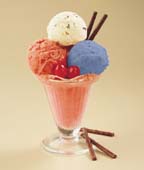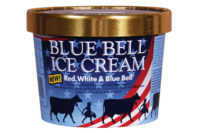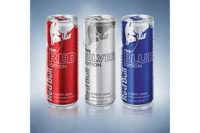As the season of fun in the sun nears its end, and harvesting time commences, dairy food and beverage manufacturers should look to their farming friends for ways to add value to dairy products by naturally adding color and flavor from the fruits (and vegetables) of the season. Many natural colorants are obtained from plants, and while they provide color, they also do a nice job of adding flavor. Let's explore the world of natural colorants.

Highly regulated ingredients
Federal regulations (Title 21of the Code of Federal Regulations, parts 70 to 82) govern the use of coloring agents, separating them into two general categories-certified and exempt from certification. All certified colors are synthetic, or artificial. They sound "chemically," too, as when they are listed on ingredient panels they have names such as FD&C Red No. 40. Some colors that are exempt from certification are also artificial. It is the natural ones that are the focus of this article.There are 31 exempt colorants listed in 21CFR73. They are obtained from various plant, animal or mineral sources, or are synthetic duplicates of the same. They include dyes, pigments or other substances capable of coloring foods and beverages.
Some of the 31 are listed very generically such as fruit juice (21CFR73.250) and vegetable juice (21CFR73.260), while others are very specific, such as annatto extract (21CFR73.30). Even though these colorants are exempt from certification, they must still meet FDA specifications. Many of them are also restricted to use either in particular products or at specific levels. For example, not all 31 are permitted in human foods. Some are allowed only to color animal feed.
Why add color? Color is an important property of foods and beverages. Nature teaches us to expect certain colors in certain foods. One of the best examples of how added color makes a food more appealing is the citrus fruit orange. Many consumers believe that fresh-from-the-tree ripened oranges, with their brownish, mottled green peel, do not taste right. So, it is very common for oranges to be sprayed orange, thus promoting acceptance by consumers who may otherwise avoid this natural fruit loaded with vitamins and fiber.
On the dairy side, strawberry ice cream should have a red hue, while coffee milk should be brown. Often times the ingredients used to make these colorful products need some enhancement to convey the flavor. For example, the yogurt used to make a mixed berry smoothie may mellow some of the reds and purples from the added berries. A little boost of color can make this drink more eye appealing to consumers.

Common colors for dairy
There are numerous exempt colorants that are used in dairy foods. In fact, caramel color is one of the most widely used in all food and beverage products. It is made by heating food-grade carbohydrates, generally a high dextrose-containing starch hydrolysate or corn syrup. The resulting colorant ranges from golden brown to nearly black.But remember, we are talking about obtaining colors through harvested goodies. With that in mind, there are basically two classes of colors obtained from plants. First, there are the colors extracted from different parts of a plant, such as the root, the seed, etc. These are natural, in one sense, and not natural in another. They are obtained from plants, but often from parts of plants that people would not normally eat. Furthermore, they are often extracted using organic solvents.
One such common color extract is annatto, which is a yellow food colorant obtained from the seeds of the Bixa orella tree. Another is turmeric. Somewhat brighter in yellow color, tumeric is made from the roots of the plant Curcuma longa L. At high pH, this bright yellow colorant turns orange. For a bright orange to red orange color, there's paprika, which is extracted from the pod of Capsicum annum.
Then there are the actual whole fruits or vegetables, and their juices. When edible fruits and vegetable are used to color foods, the products are often much better received by label-reading consumers than if colored with something synthetic. Indeed, consumers are looking for natural and wholesome foods and beverages that have fresh, appealing color, thus, the market for natural food colors has been growing in recent years, and shows no sign of slowing down.
Suppliers tend to use physical processes to obtain colorants from fruits and vegetables. They avoid the use of chemicals, using only water or vegetable oil as the solvent.
There are some extracts of fruits and vegetables that have their own listing in the CFR. This includes beet powder (bluish-red), carrot oil (orange) and grape skin extract (reddish-purple). Others fall into the generic listing of fruit juice or vegetable juice.
Two commonly used vegetable juices used to color dairy products are red cabbage and beet. Red cabbage juice produces a bright pink to red color in products with a pH of less than 4. A higher pH causes the pigments to turn an unstable purplish blue color. Beet juice provides a bluish-red color that is more stable at a higher pH range than red cabbage juice.
In general, colorants based on the pigments referred to as anthocyanins (blue to red) are affected by pH. Natural color suppliers often provide anthocyanin stabilizers to improve stability and enhance the color of anythocyanin-based colors. Most natural colors based on carotenoids (orange to yellow) are not impacted by pH.
Other fruit juices being used to color dairy foods include black currant, blueberry, elderberry, pumpkin, raspberry and tomato. That's right, pumpkin and tomato. Pumpkin and tomato are both fruits, and their concentrated juices have been shown to provide a pleasing color to dairy foods, without contributing any undesirable flavors. For example, pumpkin juice can color cheese products orange, as well as provide a creamy yellow hue to milk beverages flavored banana and lemon. Tomato juice works real well in dips and even ice cream.
The benefit to using such colorants is they add value by contributing to a natural halo, as they are listed on ingredient panels as, for example, carrot and beet juice (for color).
When working with natural colors such as these, there are various factors that affect stability. For example, extreme heat such as that encountered in ultra pasteurization can cause a pigment to change shades. Active bacteria such as those found in cultured products can also break down certain colors, and prolonged exposure to the atmosphere or to light can cause color to fade or brown.
Unfortunately, if patriotic colors are your goal, obtaining the red is feasible through the use of fruit and vegetable juices, but blue and white are not. The only way to get brilliant blue or royal blue is through the use of certified colors, FD&C Blue No. 1 and FD&C Blue No. 2, respectively. For white, titanium dioxide, an exempt color, but not the most appealing sounding, will impart an opaque appearance to foods and beverages, making it appear white.
When it comes to coloring foods and beverages, it might be alright to put your patriotism aside.


